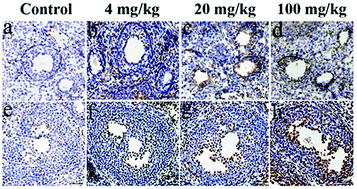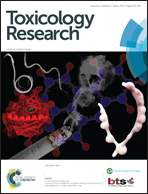Aroclor 1254 impairs the development of ovarian follicles by inducing the apoptosis of granulosa cells
Abstract
Recent observations have indicated that polychlorinated biphenyls (PCBs) can reduce the number of antral follicles and increase follicular atresia. However, the effect of PCBs on follicles at each developmental stage and its underlying mechanism remain unclear. The aim of the present study was to evaluate the effects of PCB commercial mixtures (Aroclor 1254) on follicles at four developmental stages and apoptosis of mouse granulosa cells in vivo. Aroclor 1254 was administered to ICR female mice by intraperitoneal injection at the dose of 4, 20 and 100 mg kg−1 b.w. once every 3 days for five times. The number of follicles, the percentage of apoptosis and the ultrastructure of granulosa cells were determined. The results showed that Aroclor 1254 reduced the number of primordial and antral follicles in a dose-dependent manner and increased the apoptosis of granulosa cells in the mice treated with 20 mg kg−1 and 100 mg kg−1 Aroclor 1254. Transmission electron microscopy analysis showed that mitochondrial dysfunction occurred in the granulosa cells of mice treated with 100 mg kg−1 Aroclor 1254. Finally, treatment of mice with Aroclor 1254 significantly reduced the expression of Bcl-2 mRNA and increased the ratio of Bax to Bcl-2 mRNA in granulosa cells. Based on these results, we concluded that exposure to Aroclor 1254 impaired the development of follicle (primordial follicle excluded), possibly via the induction of apoptosis mainly in granulosa cells. These findings suggest that PCB pollutants may cause premature ovarian failure and infertility of humans.


 Please wait while we load your content...
Please wait while we load your content...